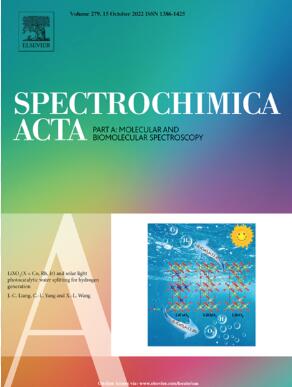Utilizing pillararenes as capping agents to stabilize copper nanoparticles for cost-effective and high-performance SERS application
IF 4.3
2区 化学
Q1 SPECTROSCOPY
Spectrochimica Acta Part A: Molecular and Biomolecular Spectroscopy
Pub Date : 2025-02-17
DOI:10.1016/j.saa.2025.125919
引用次数: 0
Abstract
Gold, silver, and copper nanoparticles (CuNPs) exhibit strong localized surface plasmon resonance (LSPR) effects at specific sizes, which can amplify the Raman signals of adsorbed molecules. However, despite the cost-effectiveness of CuNPs, their applications in surface-enhanced Raman spectroscopy (SERS) are limited due to their susceptibility to surface oxidation and particle aggregation. In this study, three distinct capping agents—pillararenes, polyvinylpyrrolidone, and sodium citrate—were employed to enhance particle dispersion, improve stability, and protect the CuNPs from oxidation and degradation. The synthesized CuNPs were thoroughly characterized using UV–Vis absorption spectroscopy, transmission electron microscopy, energy-dispersive X-ray spectroscopy and Raman spectroscopy. Results revealed that CuNPs capped with pillararenes demonstrated superior SERS enhancement effects when using 4-aminothiophenol as the probe molecule, achieving an enhancement factor of 3.7 × 105. Furthermore, pillararene-capped CuNPs exhibited a broader linear range in SERS quantitative detection applications. This proposed method offers a versatile and cost-effective SERS substrate compared to commercial gold and silver nanocolloids, positioning it as a promising candidate for a wide range of SERS applications.

求助全文
约1分钟内获得全文
求助全文
来源期刊
CiteScore
8.40
自引率
11.40%
发文量
1364
审稿时长
40 days
期刊介绍:
Spectrochimica Acta, Part A: Molecular and Biomolecular Spectroscopy (SAA) is an interdisciplinary journal which spans from basic to applied aspects of optical spectroscopy in chemistry, medicine, biology, and materials science.
The journal publishes original scientific papers that feature high-quality spectroscopic data and analysis. From the broad range of optical spectroscopies, the emphasis is on electronic, vibrational or rotational spectra of molecules, rather than on spectroscopy based on magnetic moments.
Criteria for publication in SAA are novelty, uniqueness, and outstanding quality. Routine applications of spectroscopic techniques and computational methods are not appropriate.
Topics of particular interest of Spectrochimica Acta Part A include, but are not limited to:
Spectroscopy and dynamics of bioanalytical, biomedical, environmental, and atmospheric sciences,
Novel experimental techniques or instrumentation for molecular spectroscopy,
Novel theoretical and computational methods,
Novel applications in photochemistry and photobiology,
Novel interpretational approaches as well as advances in data analysis based on electronic or vibrational spectroscopy.

 求助内容:
求助内容: 应助结果提醒方式:
应助结果提醒方式:


